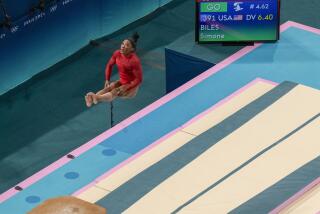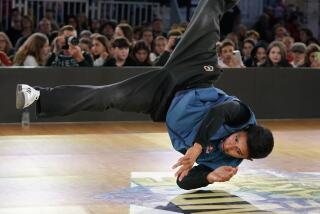Serious Flight Risk
Competitors blast full bore down runways and lean hard into fiberglass poles, propelling themselves in an arc over a bar set as high as two stories above the ground.
Is it any wonder that the pole vault has always been a favorite event of track and field fans?
Vaulters are fancied as quintessential athletes, relying on sprinter’s speed, a body builder’s strength and the agility of a lithe gymnast as they soar ever higher into the sky and the record books.
And, increasingly it seems, they require one more characteristic: The nerve of a daredevil.
The pole vault is the most dangerous of school-sanctioned athletic events, according to statistics compiled by the National Center for Catastrophic Sports Injury Research in Chapel Hill, N.C.
This year, three teenagers have died from injuries sustained while vaulting. Jesus Quesada, 16, of Clewiston (Fla.) High; Kevin Dare, 19, of Penn State; and Samoa Fili II, 17, of Wichita (Kan.) Southeast High are the 18th, 19th and 20th vaulters to die since 1980.
At meets like the NCAA championships, which started Wednesday in Baton Rouge, La., and the state high school championships, which are today and Saturday at Cerritos College, pole vaulters will attempt to reach record heights.
As the bar climbs, so do calls for more stringent safety measures.
“Those accidents are a reminder for all of us that we [participate in] a serious sport and we need to be careful,” said Paul Litchfield, who set a Big Sky Conference record of 17 feet 8 inches for Idaho State this month. “We need to do everything we can to make the event as safe as possible.”
The National Federation of State High School Assn. (NFHS) is considering several proposals to make the popular event more safe. Among them:
Increasing the size of the foam-rubber landing mat.
Marking an ideal landing area on the mat to make it obvious if vaulters are landing wrong and need to make an adjustment in a technical aspect of their jump.
Requiring that the edges of the metal “box”--in which vaulters plant the tips of their poles--to be covered by a padded collar.
Requiring vaulters to wear protective helmets like those worn by skateboarders and inline skaters.
But one prominent coach says the event would be far less dangerous if event organizers, coaches and athletes would adhere to the safety measures already in place.
“The rules we currently have on the books are not that bad,” said Jan Johnson, the 1972 Olympic bronze medal winner and chairman of USA Track & Field’s pole vault safety committee. “But of the nine catastrophic [vaulting] injuries that occurred [from 1995-2001], all came at facilities that were out of compliance [with the safety standards established in 1995]. And of the [24] catastrophic injuries that occurred in the seven years before that, every one of them came at facilities that would not have met the safety standards adopted in 1995.”
“Catastrophic” accidents are those that lead to the death of a vaulter or to a serious injury such as coma, paralysis, severe concussion, skull fracture or broken neck.
Locally, there have been two deaths. In 1980, Cliff Snyder, 23, died in a vaulting accident at San Diego State when he flipped off the back of the landing mat and hit his head on asphalt. In 1997, Heath Taylor, 16, was killed in similar circumstances during a practice at Newhall Hart High.
News reports on Taylor’s death said Hart’s 20-foot-by-22-foot landing mat exceeded national safety recommendations, but the hard surfaces around the pit were not covered by padding in accordance with standards adopted two years earlier by the NFHS.
Taylor’s parents sued the William S. Hart Union High School District for wrongful death in December 1997, a case that was settled out of court in 1999.
Madonna Taylor, Heath’s stepmother, said the suit was filed, in part, to publicize that some schools weren’t adhering to all the safety standards. “We wanted to send a message to any high school or college that they shouldn’t be doing this if they weren’t going to follow the rules,” she said. “But in the end, it just would have been too painful to relive the whole thing again in court.”
The NFHS adopted several new safety measures for the pole vault in 1995--the requirement for additional padding around the landing pit among them. Other guidelines were instituted preventing vaulters from holding the pole at a height above a line deemed safe by the manufacturer and from jumping on poles that were recommended for athletes who weighed less.
The rule limiting how high a vaulter can grip a pole is designed to increase the chances of competitors maintaining control of their direction. Experts say younger and less experienced vaulters were getting in trouble by trying to emulate world-class athletes who were using longer poles and gripping them unconventionally higher.
The rush to reach greater heights similarly prompted some vaulters to use poles that were marked for use by lighter athletes, figuring the more they could bend the poles the more strongly they would be propelled. Some poles snapped, or launched vaulters in dangerous angles.
Until this year, the rule changes seemed to work.
The number of catastrophic injuries dropped 60% compared to the seven-year span before the 1995 rule changes, according to a study conducted by Johnson and doctors Paul Pilla and Barry Boden of Landover, Md.
Critics attribute the sudden rash of deaths to some high schools still not adhering to all the safety measures established in 1995, particularly that of covering hard surfaces with padding. And some colleges don’t cover all exposed hard surfaces because collegiate rules don’t require it.
Quesada and Fili died of injuries sustained when their heads hit uncovered hard surfaces after they had either slid off the landing pit or hit the pad with their bodies but struck their head on an uncovered hard surface.
Dare died after hitting his head on the metal box where vaulters plant the tips of their poles to create the bend that springs them toward the crossbar.
Cerritos College, which hosted the Southern Section Masters Meet last Friday, and Van Nuys Birmingham High, which hosted the City Section championships on May 23, have vaulting facilities that meet the safety standards passed in 1995. But when Bakersfield College hosted the Central Section high school championships on May 16, the base of the metal standards that hold up the bar were left exposed.
“For something as simple as that to be left out at a facility of that caliber was surprising,” said David Costa, who has helped coach his daughter, Kira, during her first season of pole vaulting for Lemoore High. “We were at several high schools this season that didn’t have all the padding, but I was surprised to see that at a place like [Bakersfield College].”
Costa was not aware that Bakersfield is not required to cover hard surfaces in order to compete at the community college level. Nor are there rules prohibiting college vaulters from gripping a pole above the maximum hold line or from jumping on poles that are recommended for lighter athletes.
“I think the feeling has always been that college coaches are dealing with kids with higher skill levels,” Johnson said about the lack of strict college safety standards. “That might be a mirage.”
The size of the landing pad is one area where colleges and high schools have identical safety standards.
Both the NCAA and NFHS require the minimum width of the landing pad to be 16 feet 6 inches and the minimum length to be 12 feet from the back of the vaulting box to the back of the pad. But those dimensions are expected to be increased to six meters (to 19-8) by five meters (to 16-5) when an NFHS rules review committee meets in Indianapolis next month.
The NFHS might wait a year to implement the change if it feels that a large number of schools will have difficulty paying for the modular sections that would attach to the current landing pits and help them meet the new specifications.
The estimated cost of the modular sections is $1,500, compared to the $7,000-$8,000 needed to purchase a new pit.
One change that is not likely to occur soon is the mandated use of helmets by vaulters.
Minnesota, which adopted its rule shortly after Dare’s death at the Big Ten Conference Indoor championships in Minneapolis, and North Dakota are the only states that require vaulters wear helmets.
Legislation was proposed this year to make helmets mandatory in New York, but has been stalled by concerns that the New York State High School Athletic Assn. could be liable if it forces vaulters to wear helmets that are not designed specifically for the pole vault and there is an injury that gets blamed on the helmet.
Since his son’s death, Ed Dare has become a proponent for a mandatory helmet rule, saying it would significantly decrease the number of catastrophic injuries. Not everyone agrees.
Kelsey Koty, the only female in the U.S. to have suffered a catastrophic injury while vaulting, was in a coma for nearly two weeks last year after being injured while competing for Eastern Washington University in an indoor meet.
Koty hit her head on the field-house floor at Eastern Washington after flipping off the side of the landing mat, but says she might have suffered a more serious injury had she been wearing a helmet.
“[Doctors and some coaches who saw what happened] said that because of the way I landed and the angle I came down, I could have snapped my neck had I been wearing a helmet,” she said.
Toby Stevenson, a six-time All-American vaulter at Stanford from 1997-2000, scoffs at the notion that wearing a helmet could increase his chances of sustaining a severe head injury.
“There hasn’t been anybody hurt [in a vaulting accident] while wearing a helmet,” said Stevenson, who cleared a career-best 18-10 on Sunday in the Prefontaine Classic in Eugene, Ore. “It’s just another measure you can take to protect yourself in case of an accident.”
Stevenson began vaulting when he was 12 and started wearing a helmet at his parents’ insistence during his senior season at Odessa (Texas) Permian High in 1995.
He at first opposed wearing a helmet because it didn’t look “cool” and he was concerned it would have a negative impact on his performances. But it hasn’t hindered his vaulting.
“I think I’m proof that that’s not the case,” Stevenson said. “I’m not a great vaulter, but I am pretty good. I was a 17-foot vaulter in high school, an 18-foot vaulter in college, an Olympic trials finalist [in 2000] and I hope soon to be a 19-foot vaulter.”
Still, vaulters such as Johnson’s daughter, Chelsea, a senior at Atascadero High, aren’t sold on helmets.
“If you’re a dangerous vaulter, then you should wear one,” said Johnson, the top girls’ vaulter in the nation with a best of 13-6. “But if you’re a safe vaulter who doesn’t take unnecessary chances, you don’t need to wear one.”
Dave Nielsen, the men’s and women’s track coach at Idaho State and the women’s pole vault development coordinator for USA Track & Field, says a helmet probably would not have saved Dare’s life because he fell from a height of about 16 feet. But he started making his two sons in high school and his vaulters at Idaho State wear helmets shortly after Fili’s death.
“To be honest, I’ve never been real big on the helmet thing,” Nielsen said. “But after those three accidents, I felt like [our vaulters at Idaho State] could set an example for high school kids. That we could show we were aware of the risks involved in vaulting.”
Litchfield, who competes in a green, black and white camouflage helmet he has decorated with pliable spikes made out of black electrical tape, says it’s crucial that inexperienced vaulters wear helmets.
“If coaches made kids wear helmets when they first started vaulting, it’d be like second nature to them and they wouldn’t have a problem with it,” he said.
Jan Johnson isn’t sold on the safety benefits of helmets, but he is convinced the pole vault must become safer if it is going to survive at the high school level in the U.S.
“We need to [make safety improvements] or we’re going to lose the sport,” he said.
*
(BEGIN TEXT OF INFOBOX)
*--* Unsafe Landings A list of catastrophic pole-vaulting accidents in the U.S. since 1970, based on research by Jan Johnson, chairman of USA Track & Field’s pole vault safety committee, and doctors Paul Pilla and Barry Boden. These accidents resulted either in death or an injury such as a coma, paralysis, severe concussion, skull fracture or broken neck. Deaths are in parentheses 1970--0 1987--1 (1) 1971--1 1988--4 1972--0 1989--5 (1) 1973--0 1990--3 (1) 1974--0 1991--3 (2) 1975--0 1992--2 1976--0 1993--3 (1) 1977--0 1994--4 (2) 1978--0 1995--1 (1) 1979--0 1996--0 1980--1 (1) 1997--4 (2) 1981--0 1998--2 (2) 1982--2 (1) 1999--0 1983--2 (2) 2000--2 1984--0 2001--0 1985--1 2002--4 (3) 1986--1 Total--46 (20) Note: Of these accidents, 31 involved high school vaulters and 10 involved college athletes. Of the 20 who died, 15 were in high school, two in college, one in middle school, one was a coach and the other was a post-collegiate competitor
*--*
More to Read
Go beyond the scoreboard
Get the latest on L.A.'s teams in the daily Sports Report newsletter.
You may occasionally receive promotional content from the Los Angeles Times.








